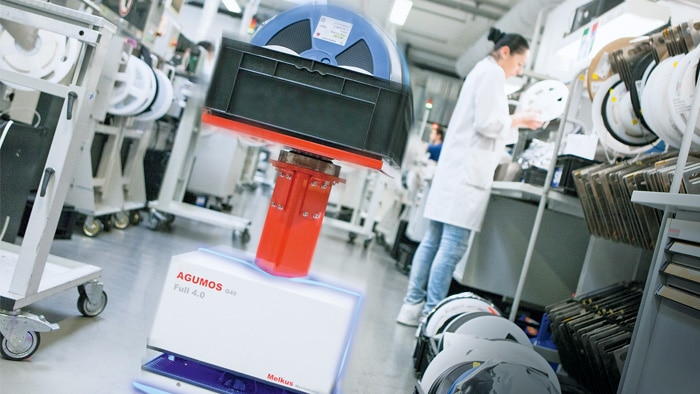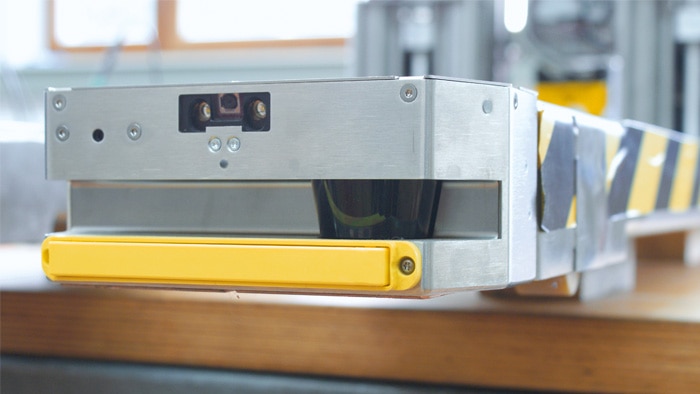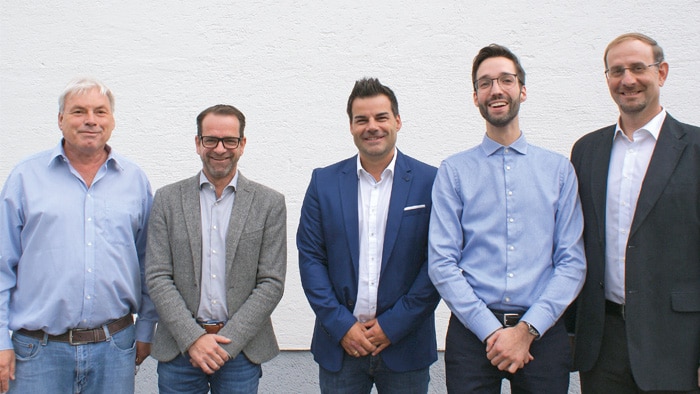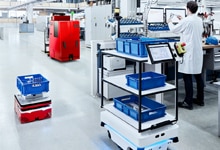What is still rather in its infancy in road traffic has long been an everyday thing in many companies: automated guided vehicles (AGVs). They ensure problem-free work processes, and are setting new standards when it comes to flexibility. This is Melkus Mechatronic’s speciality. This Salzburg company sets great store on a highly modular vehicle concept and the sensor technology from SICK, which offers a lot of scope for creative logistics solutions at their finest.
Modular and mobile – AGVs on the move providing maximum flexibility
Flexibility is becoming an increasingly decisive factor in production, and the key to implementing batch size 1 economically. Andreas Melkus is the founder of the electronics company Sigmatek and, together with Melkus Mechatronic, has been ensuring movement in the automated guided vehicle system market in the true sense of the word since 2014. One thing is clear to him: “In future, there will no more rigid linkages in many production facilities but rather flexible manufacturing processes where work cells are formed and disassembled again as required. This machine vision fascinated me and led me to intra-company logistics”.
With Melkus Mechatronic, Andreas Melkus fulfilled the prerequisites for his company’s entry into the world of AGVs. Technology from Sigmatek was, of course, incorporated from the beginning. “We had access to electronic and mechanical components from Sigmatek, and a top R&D department that was willing to further develop solutions in a targeted manner – a perfect partnership.“
Compact design with a low area load
Agumos is the name of the nimble AGVs with which Melkus Mechatronic is bringing movement into production. The essential aspects in their design were maneuverability, a compact construction, a low area load and, in particular, modularity so that a wide variety of AGVs could be implemented based on a single concept – from transporting small and large crates right through to fully loaded pallets. The drive system of the Agumos AGVs is distributed across eight wheels thereby creating a relatively low point load on the floor, and the rotating drive units ensure no wheel ever spins on the spot.
The range is crucial
The distance covered until the next recharge is a decisive factor for AGVs. During the development of the transport vehicle platform, particular attention was therefore paid to minimizing the own weight of the vehicle and to energy recover in order to achieve the highest possible range with the rechargeable batteries. Andreas Melkus: “A well thought through design, the use of a state-of-the-art rechargeable battery technology, a reliable and fast WLAN technology, and several other important developments have made AGVs as compact as these possible for the first time. Agumos puts us on excellent footing. The platform is based on an optimally tailored package of drive technology, construction, efficiency, and safety technology. That gives us the advantage for applications in wide variety of areas.”
Safety onboard
Top safety technology is essential for an AGV. While it was previously still sometimes assumed that these vehicles would only be used in partitioned off areas, we now know that this is unrealistic in practice and over longer periods because humans need to intervene from time to time. Andreas Melkus: “Hardly anyone these days would invest in a transport solution where the entire system needs to be switched off when servicing is required. The vehicles must therefore guarantee the safety of people when in operation. This requires, of course, the use of top notch sensors. SICK has proven to be the right partner for this.”
Speed demands PL d
Where humans are involved, sensors, evaluation units and actuators – that is, the entire chain within the system – need to meet the demanding performance level d otherwise it’s necessary to “step off the gas”. Andreas Melkus: “If the required safety is not assured, the speed of the AGVs must be reduced to under 300 mm per second. This ‘crawling pace’ is naturally undesirable to operators if larger distances need to be traversed. A highly reliable safety scanner is therefore required. The S300 Expert safety laser scanner from SICK is the perfect solution for us as it enables performance level d according to EN ISO 13849 to be achieved. That allows the Agumos to move at a decent pace.”
Safety laser scanner with 48 protective fields
The variants of the S300 safety laser scanner differ primarily with regard to the number of configurable protective fields. This opens up a wide range of application possibilities. Werner Zipperer, Market Product Manager Industrial Safety & Motion Control Sensors at SICK Austria: “The ‘Professional’ and ‘Expert’ variants are used in particular in mobile applications because they have the highest number of freely configurable field sets, a raw data interface, and also dynamic inputs via which the encoder signals from the drive can be directly processed – this makes them ideal for the AGVs of Melkus Mechatronic.”
Raw data included
When a protective field is interrupted by a person, an appropriate safety function is triggered. Werner Zipperer: “Decreasing the speed of movement, acoustic and visual warnings, as well as a complete stop can be implemented depending on the requirements. Furthermore, the safety laser scanners also offer an RS422 interface that is used to transmit raw data and for navigation support.“ Andreas Melkus: “We have installed here 17 safety and eight higher-level processors that monitor the individual drive units, the drive units collectively, and also the kinematics.” When driving in a circle, each wheel rotates at a different speed. That produces a turn in so that a circle ensues. “If something is not right overall, the safety controller intervenes. That means: We are not only driving here with the correct speed, but also in the correct direction” says Melkus.
Compact safety
The installation space is an important factor with AGVs – that applies not only to the slim S300. The space in the blades, which are essential for transporting pallets and which need to be precisely inserted under the pallet when taking up the pallet, is also particularly limited. Every millimeter counts in this case. Space is tight in particular in the height dimension because the blades must not project upwards anywhere. Melkus therefore turned again to the sensor specialist SICK for help: “The experts modified a 2D LiDAR sensor for us in such a way that we could install it directly into the forks – a solution that had previously not existed.”
Fine positioning thanks to a 2D LiDAR sensor
While the S300 Expert ensures the safety of humans and machines when the AGV is traveling at full speed, the task of the TiM5 2D LiDAR (light detection and ranging) sensor is to precisely position the blades as they are slowly inserted under the pallet. A detection sensor is installed on the tip of each blade. René Klausrigler, Market Product Manager Identification and Measurement at SICK Austria: “When inserting the blades under the pallet, which is performed while the AGV is reversing, the TiM5 2D LiDAR sensor supplies the data for finely positioning the AGV. The available installation height within the blade was a real challenge. We were able to implement this using a variant of our TiM sensor that we developed specifically for this application. The design of the sensor was specially adapted for the blade. That required real teamwork.”
Flexible solution for Manufacturing 4.0
Even though the goal at Melkus Mechatronic is for the AGVs to go into series production, they have long had not only “off the shelf” AGVs. They also respond to customer requests. Andreas Melkus: “We developed Agumos to be modular from the outset. That is the key to true flexibility as required for Manufacturing 4.0. “AGVs have taken a giant leap forward into the future in recent years and – as Andreas Melkus is certain – will increasingly replace stationary conveying equipment thanks to their flexibility and decreasing purchase price. An important building block for implementing Industry 4.0. Full steam ahead!
From left: Andreas Melkus, proprietor of Melkus Mechatronic; René Klausrigler, Market Product Manager Identification and Measurement at SICK Austria; Andreas Preuner, Team Leader Sales/Key Account Manager at SICK Austria, Patryk Hoffman, General Manager of Melkus Mechatronic; Werner Zipperer, Market Product Manager Industrial Safety and Motion Control Sensors at SICK Austria
Read more:
Automated production logistics with automated guided vehicle systems
Interview about 4.0 NOW factory: "Combining innovations"
Complete sensor solutions for AGC systems in CEP distribution centers
AGVs from CEIT use Visionary-T from SICK for collision protection




